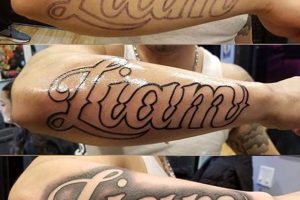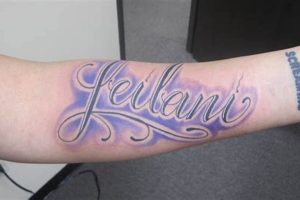Wrist tattoos featuring names represent a popular form of personal expression. This style of body art allows individuals to carry the names of loved ones, inspirational figures, or even cherished pets close at hand. Examples include a child’s name rendered in elegant script, a partner’s initials interwoven with a symbolic design, or a pet’s name accompanied by a small paw print.
The enduring appeal of this type of tattoo stems from its ability to serve as a constant reminder of meaningful connections and personal values. Historically, body art has served various purposes, from tribal affiliations to spiritual practices. Modern approaches frequently focus on aesthetics and personal significance, with name tattoos embodying a deeply personal form of remembrance and tribute. Their placement on the wrist offers both visibility for the wearer and a discreet option for professional environments.
Factors to consider include typeface selection, design elements, and the overall aesthetic of the tattoo. Further exploration of these elements will provide a comprehensive guide to making informed decisions about permanent body art.
Tips for Wrist Name Tattoos
Careful consideration should be given to various factors before committing to a permanent wrist tattoo. The following tips offer guidance for achieving a visually appealing and personally meaningful result.
Tip 1: Font Selection: Typefaces dramatically impact the overall aesthetic. Script fonts convey elegance, while block letters offer a bolder statement. Research various font styles to determine the most appropriate representation of the desired message.
Tip 2: Size and Placement: Wrist size should inform design choices. Smaller wrists benefit from delicate, minimalist designs, while larger wrists allow for more intricate artwork. Consider the natural curvature of the wrist for optimal placement.
Tip 3: Incorporating Design Elements: Enhance visual interest by incorporating symbolic elements. Flowers, hearts, or geometric patterns can complement the name and add layers of personal meaning.
Tip 4: Professional Consultation: Discuss ideas with a reputable tattoo artist. Experienced professionals can offer valuable insights into design, placement, and aftercare.
Tip 5: Pain Tolerance: The wrist can be a sensitive area. Mental preparation and open communication with the tattoo artist can help manage discomfort during the process.
Tip 6: Aftercare Considerations: Proper aftercare is crucial for healing and longevity. Follow the artist’s instructions diligently to minimize the risk of infection and ensure the tattoo heals properly.
Tip 7: Think Long-Term: A tattoo is a permanent commitment. Thorough consideration of the chosen name and design is essential to avoid future regrets.
By carefully evaluating these factors, individuals can ensure a wrist name tattoo that serves as a source of personal pride and lasting meaning.
These considerations are crucial for achieving a satisfying and aesthetically pleasing outcome. A well-executed wrist tattoo can become a cherished piece of personal art.
1. Placement
Placement is a critical factor in wrist tattoo design, particularly when featuring names. The wrist offers distinct areasinner, outer, top, and sideeach presenting unique advantages and disadvantages. The inner wrist, often considered a more private placement, provides a discreet option easily concealed by long sleeves. This area tends to be more sensitive, requiring careful consideration of pain tolerance. Conversely, the outer wrist offers greater visibility, allowing for a bolder statement. This location experiences more frequent contact and sun exposure, potentially impacting long-term ink vibrancy. The top of the wrist presents a less common but increasingly popular choice, providing a balance between visibility and discretion. The side of the wrist, curving around the arm, allows for creative designs that follow the natural contours of the body. A name styled to follow this curve can create a unique and aesthetically pleasing flow.
Practical considerations inform placement decisions. Individuals in professions with strict dress codes may prefer the inner wrist’s concealability. Those seeking a prominent display might opt for the outer wrist. Lifestyle also plays a role. Active individuals who engage in sports or manual labor should consider potential friction and sun exposure when selecting placement. For example, a musician might choose the inner wrist to avoid interference with playing an instrument, while an artist might prefer the outer wrist for a more visible display. Placement also interacts with design choices. Longer names might suit the outer wrist’s larger canvas, while shorter names or initials can be elegantly placed on the inner wrist or the side. The chosen placement fundamentally impacts the overall aesthetic and practicality of the tattoo.
Effective placement enhances both the aesthetic appeal and the personal meaning of a name tattoo. Careful consideration of visibility, practicality, and design interaction ensures a result that resonates with individual preferences and lifestyle. Understanding the nuances of wrist anatomy and the implications of each placement area empowers informed decision-making for a permanent piece of body art. Ignoring these considerations can lead to dissatisfaction with the final result, emphasizing the importance of thoughtful planning in the design process.
2. Font Style
Font style significantly impacts the aesthetic and communicative power of name tattoos on the wrist. Typefaces convey specific moods and associations, influencing how the name is perceived. A delicate script evokes elegance and femininity, often chosen for names of children or partners. Conversely, a bold, blocky font projects strength and permanence, suitable for memorializing a loved one or expressing personal resilience. Calligraphic styles offer a personalized touch, reflecting artistry and individuality. Consider the name itself; a short, simple name might benefit from a more ornate font, while a longer name might require a simpler, more legible style. For example, the name “Ava” rendered in an elaborate script adds a touch of sophistication, whereas a name like “Alexander” might appear cluttered in the same style, benefiting instead from a clean, modern font. The chosen font should complement the name’s meaning and the wearer’s personality.
Practical considerations influence font selection. Intricate fonts with fine details might blur or fade over time, especially on the wrist’s delicate skin. Bold, simpler fonts generally retain their clarity longer. The tattoo artist’s skill also plays a crucial role; some specialize in specific styles. Consulting a professional ensures the chosen font translates effectively into a permanent design. Viewing the artist’s portfolio reveals their proficiency with different font styles, informing the selection process. Size constraints on the wrist necessitate careful font selection. Highly decorative or elaborate fonts might appear cramped in a smaller size, compromising legibility. A balance between aesthetics and practicality ensures a visually appealing and enduring tattoo.
Successful font selection hinges on understanding the interplay between aesthetics, practicality, and personal expression. The chosen typeface should complement the name, resonate with the wearer’s identity, and remain legible over time. Professional consultation ensures effective execution, mitigating potential challenges related to size, placement, and long-term ink clarity. Ultimately, the right font elevates a name tattoo from a simple inscription to a meaningful and visually compelling piece of art.
3. Name Selection
Name selection represents a pivotal element in wrist tattoo design. The chosen name imbues the tattoo with profound personal significance, transforming it from a mere inscription into a powerful symbol of connection, remembrance, or inspiration. Careful consideration of the relationship with the name’s bearerwhether a child, partner, friend, pet, or inspirational figureis crucial. This connection informs the emotional weight and lasting relevance of the tattoo. A parent might choose a child’s name to symbolize enduring love, while an individual might select the name of a deceased loved one as a permanent tribute. The emotional resonance of the chosen name directly impacts the tattoo’s meaning for the wearer.
Practical implications accompany the emotional significance of name selection. Names carrying cultural or historical weight add layers of meaning, potentially sparking conversations and offering insights into personal values. However, cultural sensitivity requires careful research to avoid misappropriation or misinterpretation of symbols or names from other cultures. For instance, incorporating characters from a language one doesn’t understand risks unintentional offense or misrepresentation. Similarly, selecting names of public figures requires consideration of their evolving public image and potential future controversies. A name’s permanence underscores the need for thoughtful consideration of its long-term personal and societal implications.
Ultimately, name selection defines the core narrative of a wrist tattoo. The chosen name should resonate deeply with the wearer, reflecting enduring values and meaningful connections. Balancing emotional significance with practical considerations, including cultural sensitivity and the potential for evolving perceptions, ensures the tattoo remains a source of personal pride and positive reflection over time. This careful selection process transforms a simple act of inscription into a powerful statement of personal identity and enduring connection.
4. Design Elements
Design elements play a crucial role in enhancing name tattoos on the wrist, transforming simple text into personalized works of art. These elements add depth, symbolism, and visual interest, allowing for a more nuanced and expressive representation of the chosen name. Careful selection and integration of design elements contribute significantly to the overall aesthetic impact and personal meaning of the tattoo.
- Symbolic Imagery
Incorporating symbolic imagery alongside a name adds layers of meaning and personalization. Common symbols include hearts (representing love), anchors (stability), feathers (freedom), or religious icons (faith). For example, a child’s name accompanied by a small butterfly might symbolize transformation and growth, while a pet’s name with a paw print represents companionship and loyalty. The chosen symbol should resonate with the wearer and complement the name’s significance. Thoughtful selection ensures the symbol enhances rather than overshadows the name itself.
- Floral Motifs
Floral motifs offer a wide range of artistic possibilities. Specific flowers carry symbolic weight, such as roses (love), lilies (purity), or lotus flowers (rebirth). The style of the floral design, whether realistic or abstract, further contributes to the tattoo’s overall aesthetic. A delicate vine encircling a name can create a sense of elegance and flow, while a single, boldly rendered flower can make a powerful statement. Consideration of the flower’s size, color, and placement relative to the name ensures a balanced and visually appealing composition.
- Geometric Patterns
Geometric patterns provide a contemporary and visually striking option. Simple lines, shapes, and mandalas can frame the name or be incorporated into the lettering itself. These patterns can represent abstract concepts like balance, harmony, or infinity. A minimalist geometric design can complement a simple name, while more intricate patterns can add visual complexity to a larger design. The precision required for geometric tattoos necessitates careful consideration of the artist’s skill and experience.
- Incorporating Initials
When space is limited or discretion is preferred, incorporating initials offers a concise yet meaningful alternative to full names. Initials can be stylized in various ways, from simple block letters to elaborate monograms. They can also be integrated with other design elements, such as small symbols or geometric patterns. For example, intertwining initials with a heart or infinity symbol adds a layer of symbolic meaning without requiring extensive space. This option allows for a subtle and personalized tribute.
By carefully considering these design elements, individuals can create wrist tattoos that transcend simple inscriptions and become expressive works of art. The interplay of name, font, and chosen design elements contributes to a cohesive and meaningful composition, reflecting personal values, cherished relationships, and individual aesthetics. These elements transform a name tattoo into a powerful and personalized form of self-expression.
5. Size and Scaling
Size and scaling are critical considerations for name tattoos on the wrist. The limited canvas of the wrist demands careful planning to ensure the chosen name and any accompanying design elements are rendered legibly and aesthetically. Appropriate scaling ensures the tattoo remains visually appealing and proportionate to the wearer’s wrist size, while also considering the long-term effects of aging and skin changes on the clarity and integrity of the design.
- Proportion and Wrist Size
The tattoo’s size must be proportionate to the wrist. A large, elaborate design on a slender wrist can appear overwhelming, while a small, intricate design on a larger wrist might get lost. Careful measurement and consultation with a tattoo artist are essential to determine appropriate proportions. Visualizing the design on the wrist using stencils or temporary tattoos can help assess its suitability before permanent application.
- Font Size and Legibility
Font size directly impacts legibility, especially on the wrist’s curved surface. Small fonts, while delicate, can become illegible over time as the skin ages and stretches. Larger fonts offer better long-term clarity but might limit design complexity. Striking a balance between aesthetics and legibility is crucial for a successful wrist tattoo. Testing different font sizes with stencils can aid in visualizing the final result and ensuring readability.
- Scaling Design Elements
Accompanying design elements, such as flowers, symbols, or patterns, must be scaled appropriately in relation to the name. Overly large elements can detract from the name’s prominence, while excessively small elements might lose detail and impact. Maintaining a balanced visual hierarchy ensures all elements contribute harmoniously to the overall design. Sketching the design with various scaling options allows for careful evaluation of visual balance.
- Long-Term Considerations
Skin elasticity changes over time, potentially affecting the tattoo’s appearance. Small, intricate details are particularly susceptible to blurring or fading with age. Choosing a slightly larger scale for fine details can mitigate this risk and ensure the tattoo remains clear and defined over the years. Consulting with experienced tattoo artists can provide insights into long-term design integrity.
Careful consideration of size and scaling ensures the name tattoo on the wrist remains aesthetically pleasing and legible over time. Balancing design aspirations with the wrist’s limited canvas and the long-term effects of aging on skin requires thoughtful planning and professional consultation. By addressing these factors, individuals can achieve a wrist tattoo that serves as a lasting and visually appealing expression of personal significance.
6. Artist Consultation
Artist consultation represents a crucial step in the process of obtaining a name tattoo on the wrist. A skilled tattoo artist provides expertise that significantly influences the final outcome, impacting both the aesthetic appeal and the longevity of the tattoo. Consultation allows for personalized guidance tailored to individual preferences, wrist anatomy, and desired design elements. This collaborative process ensures the chosen name and accompanying design translate effectively into a permanent piece of body art. For example, an artist can advise on appropriate font size and style for optimal legibility on the wrist, considering factors like skin type and the chosen placement. They can also offer valuable insights into design modifications that enhance visual appeal and ensure long-term clarity.
The artist’s experience and skill are invaluable resources in navigating design choices and technical considerations. They possess a deep understanding of ink behavior on skin, proper sterilization techniques, and aftercare procedures. This knowledge base allows them to anticipate potential challenges, such as ink bleeding or fading, and recommend appropriate solutions. For instance, an experienced artist can advise against using overly intricate designs on the inner wrist, where skin is thinner and more prone to ink diffusion. Furthermore, they can recommend specific ink types and aftercare products best suited for the individual’s skin type and lifestyle, maximizing the chances of a successful and long-lasting tattoo.
Effective communication between the individual and the artist forms the foundation of a successful consultation. Clearly articulating design preferences, including font style, size, placement, and accompanying elements, allows the artist to develop a personalized design that aligns with the individual’s vision. Openly discussing concerns, such as pain tolerance or budget constraints, enables the artist to tailor the process accordingly. This collaborative approach ensures a comfortable and positive experience, resulting in a tattoo that reflects the individual’s aesthetic preferences and personal meaning. Ultimately, artist consultation mitigates potential risks, optimizes design choices, and ensures a satisfying outcome, transforming a personal vision into a beautifully executed and enduring piece of body art.
Frequently Asked Questions
This section addresses common inquiries regarding name tattoos on the wrist, providing factual information and practical guidance for individuals considering this type of body art.
Question 1: How painful are wrist tattoos?
Pain levels vary based on individual pain tolerance. The wrist is considered a moderately sensitive area due to thin skin and proximity to bone. Discomfort is typically described as a sharp, scratching sensation.
Question 2: How long do wrist tattoos take to heal?
Healing typically takes 2-3 weeks. Following proper aftercare procedures is crucial for optimal healing and minimizing the risk of infection.
Question 3: What factors affect the cost of a wrist tattoo?
Cost depends on factors such as size, complexity, artist experience, and studio location. Obtaining quotes from multiple reputable artists is recommended.
Question 4: Can wrist tattoos be covered up easily?
While concealable with long sleeves or bracelets, complete concealment might be challenging. Consider placement carefully if discretion is a primary concern.
Question 5: What are the potential risks of wrist tattoos?
Risks include infection, allergic reactions to ink, and scarring. Choosing a reputable, licensed tattoo artist minimizes these risks.
Question 6: How should one choose a reputable tattoo artist?
Research artists’ portfolios, check online reviews, and verify licensing and sterilization practices. A consultation allows for discussion of design ideas and assessment of the artist’s professionalism.
Thorough research and careful consideration of these factors contribute to a positive and informed decision-making process.
Further exploration of specific design ideas and aftercare practices will provide additional guidance.
Conclusion
Wrist name tattoos offer a powerful means of personal expression, allowing individuals to carry cherished names close at hand. Careful consideration of placement, font style, design elements, size, and artist selection ensures a meaningful and aesthetically pleasing result. These factors contribute significantly to the tattoo’s overall impact, transforming a simple name into a personalized work of art. Understanding the practical implications of wrist placement, font legibility, and long-term design integrity empowers informed decision-making. Thorough research and consultation with reputable artists are essential steps in this process.
Permanent body art represents a significant commitment. Thorough planning and thoughtful consideration of the discussed elements contribute to a lasting piece that resonates with personal meaning and artistic expression. A well-executed wrist name tattoo serves as a constant reminder of cherished connections and personal values, offering a tangible link to those who hold significance in one’s life.







